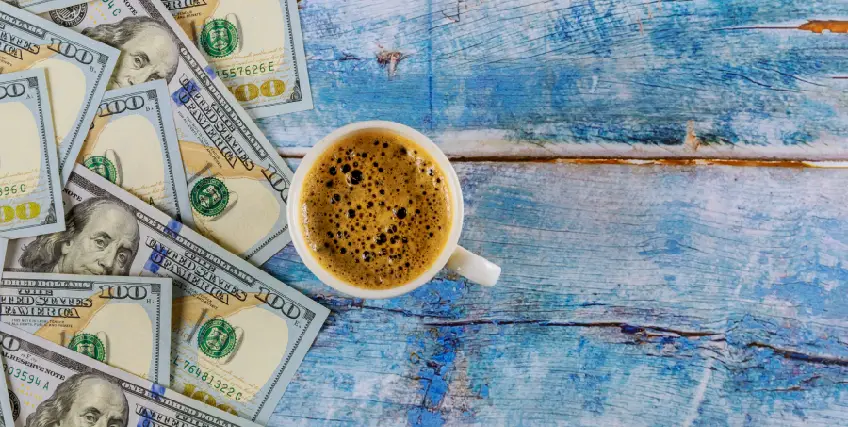How Inflation Is Reshaping the Cost of Launching a Coffee Shop
June 26, 2025 | Last Updated on: June 26, 2025

For a lot of business owners, the idea of opening a coffee shop tends to remain a popular business idea. It is almost a necessity for most Americans - a cup of coffee to begin the day. With the product being so simple, the margins can be huge and there is almost a guarantee of a steady daily footfall in most urban centers. Lately, opening a café isn’t as straightforward as it used to be. From location to products to hiring, all aspects of a coffee shop is hitting the sky, thanks to the increasing effects of inflation.
There has been a steady increase in the price of food, labor, equipment, and services in the US, due to inflation. The Consumer Price Index even highlighted that food away from home rose to 3.8% over the last year. For a small café, that shift isn’t minor; it’s a game-changer.
The annual rate of inflation has also triggered rising interest rates, driven by the Federal Reserve’s tightening of monetary policy. Small business financing has been directly impacted by this. Now opening a coffee shop has been more expensive than before, affecting how much capital entrepreneurs would need to open a shop and how long it will take them to break-even.
Inflation has now even impacted how much money it would take to run a smooth operation of a café. Once upon a time, it would cost about $20,000 to purchase the necessary equipment for coffee shops. But now that same equipment might cost you an upward of $30,000. Not only this but rent terms have become stricter and salaries are higher, all thanks to inflation triggering a high cost of living.
Understanding the causes and consequences of inflation is no longer optional; it’s critical to survival. And café owners must adapt to this new economic reality by adjusting their business model, financing strategies and even timelines for going break-even. It is no longer as simple as it was before.
Effects of Inflation: New Cost Breakdown of Opening a Coffee Shop in 2025
The effects of inflation have dramatically increased the cost of launching a coffee shop in the U.S. While startup estimates once ranged between $80,000 to $300,000, that figure now leans heavily toward the upper end and often beyond. Here's where inflation is hitting hardest:
Buildout and Renovation Costs
Construction, interior design, and remodeling costs have increased tremendously. Basic structure used to cost an average of $150–$300 per square foot. Post-pandemic rising prices and higher inflation have pushed that closer to $100 per square foot. This includes drywall, plumbing, HVAC systems, flooring, and fixtures. Add delays due to supply chain issues, and the final cost can exceed $150,000 for even modest-sized spaces.
Equipment and Machinery
A standard espresso machine that previously cost $12,000 now averages between $15,000–$19,000. The rate of inflation has impacted everything from grinders and brewers to refrigerators and POS systems. Rising production costs, international shipping fees, and increased oil prices have all contributed. Inflation has also hit warranties, maintenance contracts, and parts availability, adding hidden expenses for new owners.
Labor and Staffing
The demand for skilled baristas has outpaced supply. That, combined with national wage increases and cost of living hikes, means higher payroll costs. Owners must now budget substantially more for initial staffing than they would have in 2019. Plus, higher wages come with larger payroll tax obligations and more costly employee benefits.
Permits, Licensing, and Insurance
While these costs haven’t spiked as dramatically, cities with tight commercial real estate have increased permit fees. Additionally, inflation has caused a spike in business insurance premiums due to increased real estate valuations and economic activity risks. Expect licensing, inspections, and permits to run $5,000–$15,000, depending on location.
Altogether, the effects of inflation have transformed what was once a relatively accessible business model into one that demands far more upfront capital and precise financial planning. Coffee shop entrepreneurs in 2025 must prepare for a startup landscape defined by rising costs, inflation expectations, and tighter margins from day one.
Coffee Bean to Counter: Supply Chain Disruptions & Effects of Inflation
Inflation hasn’t just raised the price tag on starting a café; it’s also disrupted the supply chain from bean to cup. The effects of inflation are deeply felt in everyday inventory, from green coffee to to-go cups.
Commodity Price Volatility
Arabica coffee prices have increased by over 20% in the last year due to weather-related crop shortages, coupled with export problems. Milk, sugar & syrups have followed the same pattern. The rising global production costs have also triggered multiple price hikes in core café staples. These fluctuations often impact small coffee shops harder because they lack bulk-buying power.
Even disposable items, such as cups, lids, and napkins, are now significantly more expensive than before. The consumer price index reflects this steady upward climb, driven by raw material scarcity and increased transportation costs.
Logistics and Delivery Inflation
Inflation has also affected shipping and delivery, making them more expensive than before. There is a long list of obstacles pushing the prices, such as higher fuel prices, labor shortages, etc. Now, there are rising reports of inconsistent delivery schedules and mandatory minimum order sizes being levied by many cafes.
These logistics disruptions aren’t just a headache; they’re a direct bad effect of inflation. They negatively affect purchasing flexibility, increase waste risk, and strain working capital.
The effects of inflation on supply chains have an intense ripple effect. When wholesale prices rise or deliveries get delayed, profit margins tend to shrink and customer experience gets impacted. For café owners, staying on top of vendor contracts, negotiating better deals, and maintaining inventory buffers are now essential survival strategies in this competitive market.
Effects of Inflation on Break-Even Timelines
Before inflation increased tremendously, coffee shops typically expected to break even within a couple of years. But now, with rising overheads and borrowing costs, that window has increased a lot. The effects of inflation are reshaping profitability forecasts in real time.
Delayed ROI from Day One
Higher startup costs mean café owners are borrowing more. Equipment, renovations, and staffing cost more.. A business that once required $200,000 in initial investment may now need $300,000 or more. That increase immediately affects repayment schedules and cash flow.
Increased interest rates, driven by the Federal Reserve’s ongoing fight against high inflation, add to the strain. Even if revenue remains steady, profit margins shrink. More of the monthly cash goes toward covering debt, not growth.
Rising Operational Costs = Longer Ramp-Up
Daily expenses are also growing. From barista wages to cup sleeves, everything costs more. These incremental hikes, driven by rising prices and inflation expectations, chip away at potential profits. The result? Break-even projections now span 18 to 30 months, especially in urban or high-rent markets.
This prolonged runway increases financial pressure. Owners must either secure a larger loan, cut costs aggressively, or accept slower growth. And for many, that means rethinking everything—from menu pricing to store hours.
Inflation Slows Down Economic Momentum
The broader impact of inflation on economic growth also plays a role. Consumers are more cautious. Discretionary spending dips when purchasing power falls. Coffee may be habitual, but premium drinks and add-ons aren’t immune to cutbacks.
The effects of inflation make it harder not just to launch but to sustain. Breakeven now demands smarter cost control, higher efficiency, and stronger financial forecasting.
Shifting Loan Needs and Funding Strategies for Café Owners
As the effects of inflation drive up launch costs, coffee shop owners are finding that traditional loan amounts no longer cover the full picture. The financial landscape is shifting and so are funding strategies.
Higher Loan Requirements Across the Board
What used to be a $100,000 launch now often requires $150,000 or more. Equipment costs, higher wages, and longer breakeven periods are inflating funding needs. Business owners are requesting larger loan amounts to keep up with price increases and rising operating costs.
This is more than inflation; it’s a budget reset. Small café owners must now plan for cash reserves, delayed revenue, and potential cost overruns, especially in cities with aggressive rent growth.
Funding Models Adjust to Market Conditions
With the Federal Reserve pushing rates upward to curb inflation, traditional loans with variable rates are riskier. More business owners are leaning toward fixed-rate financing and flexible repayment options like revenue-based financing or short-term working capital advances.
Fixed terms help neutralize some of the volatility caused by the bad effect of inflation, especially for cafés with seasonal revenue dips. Reuters notes that businesses across the board are showing more interest in predictable repayment plans, even if the rate is slightly higher.
Smarter Borrowing for Inflation-Era Success
Borrowers today aren’t just looking for cash. They’re looking for strategy. They’re padding estimates by 20% or more, negotiating longer interest-only periods, and avoiding overleveraging early on.
In the era of inflation, financing has become complicated. Only those cafe owners can come out of this situation who plan for rising inflation and its effect on the prices.
How to Start Smart: Tips for Launching a Café in a High-Inflation Market
Inflation isn’t just a trend. It’s a reality that’s reshaping how café owners start and scale their businesses. But with the right approach, it’s still possible to build something profitable and sustainable.
Here’s how to beat the effects of inflation before they take hold:
1. Build a Bigger Budget Cushion
Everything from tiles to teaspoons is more expensive now. So, you need to budget at least 20–30% above your original estimate, covering cost overruns, delays, and even inventory shortages. If you include the price level shifts and anticipate future rising prices across categories, you would be more prepared for any future changes.
2. Lock in Fixed Contracts Early
You need to fix or lock lease agreements, equipment prices and even supplier pricing now. A fixed-rate deal will save you from future spikes and give you a breathing room. Don't go for long term contracts with variable costs, if possible.
3. Source Locally Where You Can
Importing can cost you dearly at this moment. If you do engage in importing for your cafe's necessary supplies, you are exposing yourself to currency shifts, freight costs, and global delays. A slightly higher prices paid to local vendors can save you from supply chain risk and even improve delivery timelines. That’s very important when every delay eats into launch momentum.
4. Use Compact, Efficient Layouts
Bigger isn’t always better. Design smart, minimal layouts that require fewer staff and less energy. This helps manage operating expenses, rent, and utility bills - areas where the effects of inflation quietly creep in over time.
5. Raise Prices Strategically, Not Emotionally
Don’t hike your prices every time your supplier does. Instead, track the consumer price index, monitor your gross margins, and adjust when your cost-to-sale ratio widens. Customers accept a modest increase when paired with consistent quality and experience
6. Choose Financing That Matches Your Revenue Curve
Don’t overborrow. Choose funding that aligns with your cash flow. Consider short-term financing with early payment flexibility, especially if you anticipate strong seasonal spikes. Also evaluate the causes of inflation in your region, local market dynamics often impact pricing more than national trends.
The effects of inflation are real, but they’re manageable. Café owners who remain agile, track costs closely, and make decisions proactively can still thrive, even in a market where rising costs are the new normal.
Conclusion
Inflation has changed the rules, but not the opportunity. Coffee shops still hold strong appeal for entrepreneurs across the U.S. The product is personal. The community impact is real. And the growth potential is there.
The effects of inflation have raised the stakes. Startup costs are higher. Break-even timelines are longer. Funding needs are steeper. This isn’t the time for guesswork; it’s the time for precision.
Every cafe owner, new and experienced need to understand the causes and effects of inflation to stay afloat and thrive. Every decision, from interest rates to operating expenses - now carries more weight than before. It is no longer just about brewing a perfect cup of coffee, but about building a business that can thrive even as the cost-of-living climbs.
Smart financial planning, clear budgeting and customized funding can help you launch and scale your cafe without compromising your bottom line.
FAQs
1. What are the 3 effects of inflation on coffee shop startups?
Higher startup costs, delayed break-even timelines and increase in borrowing needs are 3effects of inflation. As inflation rises, business owners are bound to spend more on labor, equipment and inventory, which will also decide how much money cafe owners might need upfront.
2. How has inflation affected supply chains for cafés?
The effects of inflation have tremendously increased shipping costs, delayed deliveries and impacts prices of necessary products like coffee beans, milk and sugar.
3. Why is it more expensive to open a coffee shop today?
Due to the effects of inflation, startups now experience higher rent, increased labor costs, and expensive materials. Everything costs more now for anyone looking to open a coffee shop.
4. How do higher prices affect my loan amount and repayment?
With rising prices across categories, loan amounts also need to be higher to cover startup and early operating costs. This leads to larger repayments and longer financial commitments.
5. What’s the bad effect of inflation on breakeven timelines?
The bad effect of inflation on breakeven is that it extends the time it takes to become profitable. Increased monthly expenses, from utilities to staffing, eat into margins.
Frequent searches leading to this page
Related Articles
Term Loans are made by Itria Ventures LLC or Cross River Bank, Member FDIC. This is not a deposit product. California residents: Itria Ventures LLC is licensed by the Department of Financial Protection and Innovation. Loans are made or arranged pursuant to California Financing Law License # 60DBO-35839




